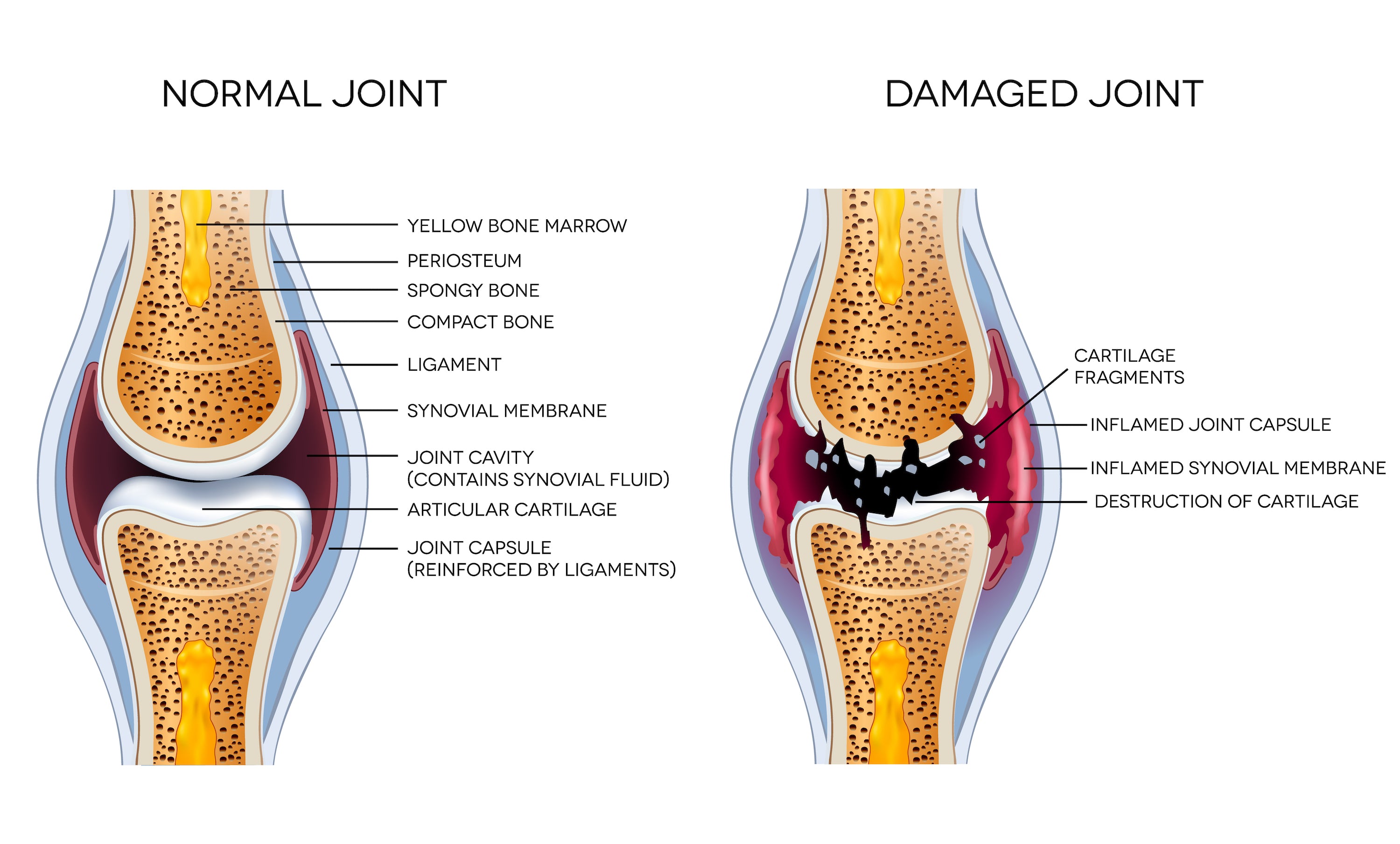What Happens to Joints as You Age?
It’s commonly accepted as an inevitable fact of life that ease of mobility and range of motion decrease over time as bones lose density, muscles lose mass, and joints break down. A number of conditions like arthritis and ankylosing spondylitis, a disease that causes inflammation in the spine and can lead to fusion of the vertebrae, can also contribute to the onset of discomfort in the joints and reduced flexibility.
It is true that the process of mineral absorption and adhesion to bones slows down with age, resulting in a loss of bone density and tissue that increases fragility. Muscles also shrink over time, losing mass through the reduction of the number and size of muscle fibers. Lean mass decreases, as does the percentage of body weight that water accounts for. This loss of water increases stress on the tissues and cartilage, which can in turn lower joint flexibility and encourage the development of inflammation around joints.
In a healthy joint, cartilage provides cushioning for smooth and easy movement. The synovium, a membrane that surrounds the cartilage caps on the ends of bones, produces synovial fluid that fills the synovium and protects the cartilage. As muscles decrease in size, the joints must absorb a greater amount of impact, causing accelerated wear and tear and encouraging the erosion of cartilage. With a reduced amount of cushioning between bones, movement can become stiff and uncomfortable. This discomfort often leads to a reduction in physical activity, which further promotes joint deterioration.

Looks like a pretty grim picture, right? But here’s the good news: While some loss of bone density and muscle mass over time is inevitable, it doesn’t have to negatively impact the joints. There are a number of ways to mitigate the effects of aging and encourage joint health for the continuation of an active, unimpeded lifestyle. And the earlier you start implementing strategies to protect your joints and maintain your mobility, the less likely you’ll be to experience difficulties related to movement or injuries caused by compensation for mobility limitations. Even if you’ve already started to feel like household chores and everyday activities aren’t as easy as they used to be, it’s not too late to make changes to your daily routine that will help discourage continuing loss of function.
Exercise
The top recommendation for the prevention of joint deterioration, exercise also encourages the retention of bone density and muscle mass. Weight training supports strength and promotes blood circulation for normal blood pressure and a lowered risk of heart disease. Low-impact activities like walking, swimming, and cycling encourage joint agility and lubrication and offer benefits for heart health, balance and coordination, oxygen intake, and body composition.
Stretching
From static stretching to yoga and pilates, movements that encourage flexibility and challenge range of motion can strengthen the core muscles, improve balance, and promote proper posture to minimize strain on tendons, ligaments, and muscles. Simple mobility routines can easily be incorporated into daily activities and provide a list of benefits when practiced consistently. Check out this five-move routine put together by physical therapist Grayson Wickham!
Diet
As the body becomes less efficient at absorbing nutrients, like the minerals needed to maintain healthy bone density, it becomes increasingly important to obtain an adequate amount of these essential compounds through a healthy diet and supplementation. Whole foods that contain calcium and vitamin D, like leafy greens, dairy products, nuts, eggs, and fatty fish, are especially beneficial for slowing the loss of bone tissue and preserving joint health.

Weight loss
Each pound of excess weight multiplies stress on joints, especially the knees, three- or fourfold. Even moderate weight loss can relieve enough pressure to slow degeneration and alleviate discomfort. Weight loss is often a happy consequence of regular physical activity and a healthy diet, and no additional strategies may be required to achieve and maintain a healthy weight. While exercise may be uncomfortable initially, shedding excess pounds can make movement more enjoyable, encouraging more frequent and varied activities.
Water intake
Hydration is vital at any age, but the loss of body water over time makes regular water intake even more essential to prevent muscles and connective tissues from becoming stiff and inflexible. Cutting out or limiting dehydrating liquids like alcoholic beverages and coffee will help ensure that the body has the fluids it needs. Choosing plain or naturally flavored water over sodas and energy drinks, which can leach minerals from the bones and teeth and cause the body to pull water from cartilage, will keep dehydration at bay and keep joints lubricated.

Smoking
What does smoking have to do with joint health? Quite a bit, actually. It’s well-known that tobacco use increases the risk of various health conditions, from heart disease to cancer, but it also negatively impacts the joints by triggering inflammation throughout the body, which can slow recovery and healing processes, and by speeding up cartilage loss, which leads to greater friction between bones. Smoking interferes with blood supply to tissues throughout the body and reduces the amount of calcium absorbed by the body. Nicotine hampers the production of osteoblasts, the cells that form bone. Bottom line: quitting – or never picking up a smoking habit in the first place – is decidedly beneficial for joints.
*These statements have not been approved by the Food and Drug Administration. This product is not intended to diagnose, treat, cure, or prevent any disease.
SOURCES
- https://www.betterhealth.vic.gov.au/health/conditionsandtreatments/ageing-muscles-bones-and-joints
- https://orthoinfo.aaos.org/en/staying-healthy/effects-of-aging/
- https://www.healthline.com/health/osteoarthritis/understanding-aging-and-joints
- https://health.clevelandclinic.org/5-best-ways-to-safeguard-your-joints-as-you-age/
- https://www.fishertitus.org/health/protect-joints-as-you-age
- https://www.healthline.com/health/improving-mobility-in-old-age
- https://hcamidwest.com/blog/entry/aging-bone-joints
- https://www.mayoclinic.org/healthy-lifestyle/fitness/in-depth/what-it-takes-to-be-agile-at-any-age/
- https://www.mountsinai.org/health-library/special-topic/aging-changes-in-the-bones-muscles-joints
- https://www.webmd.com/pain-management/features/common-pains-of-age
- https://www.bannerhealth.com/staying-well/expert/joint-pain-aging
- https://www.physio-pedia.com/Effects_of_Ageing_on_Joints
- https://orthoinfo.aaos.org/en/staying-healthy/smoking-and-musculoskeletal-health

